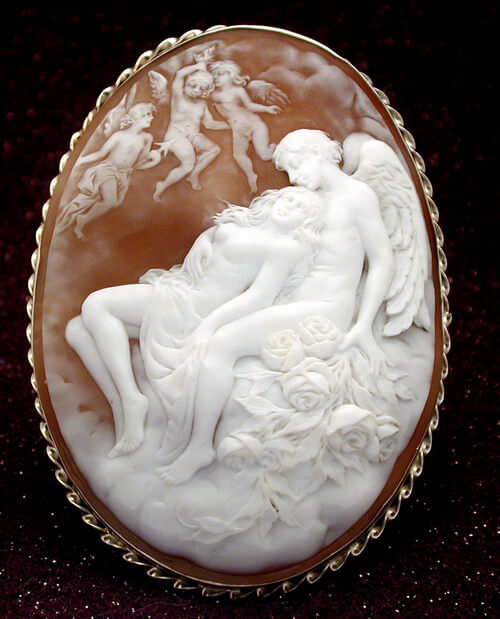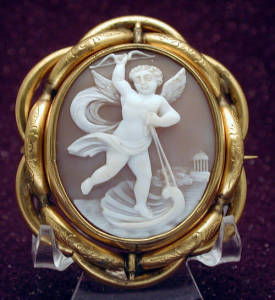Symbolism of Love: Eros, Cupid and hidden Victorian Messages in Cameos
“Since the late 1700s, Italian carvers have been in enamored by the figure of Cupid. Therefore we see all kinds of scenes depicted on classic cameos from Cupid and Venus together, to Cupid playing with goats-and often Cupid shooting an arrow. I believe that the ultimate love-god Eros is the most beautiful of all mythological gods and the most powerful. Through Eros’ love, he inspires all living things to gain love-defeating mans wisdom and carefully laid plans.”
From Diana Jarrett in her personal communication with collector/dealer Jan Campbell.
Several Victorian and more modern cupid cameos have hidden symbolism. Interpreting its secret message adds another element of enjoyment to cameo collecting. The Victorians were fond of sending covert sentimental messages hidden in flowers, gemstones, and cameo carvings. For example, a cupid riding a lion might mean “Love conquers all”. The cupid in a cage would be construed to mean “Prisoner of Love” in our modern vernacular. And the cognoscenti understood that cupid portrayed in cameos might be as moody as the real lovers who gave and received cupid cameos.
Cupid, part of the Goddess of Love Venus’ inner circle serves dual purposes of expressing tender affection for the living and paying tribute to the dead. Cupid may not always appear ‘baby-like’-but may instead be portrayed like a winged youth.
On a piece of mourning jewelry, Cupid may be seen leaning against an urn or column. When someone is mourning in real life, people will often ask: “How are you holding up” So the image is quite literal with the leaning Cupid. When Cupid conveys sorrow, he is shown in a somber pose with a pensive facial expression. The cameo background is generally black onyx, or something dark, and the
piece may be mounted as a brooch, pendant, or locket.
From the book “Cameos: Old and New”, 4th Edition, Originally written by Ann Miller, extensively updated by Diana Jarrett.
Jan Campbell provided 2 images of Cameos depicting cupid:
Image I
The Ultimate Valentine shows a variety of love bound characters on one museum quality cameo c.1930. Depicted here; Eros the love god tenderly holding his beloved who swooned into his arms. Even though we don’t see the identifying butterfly wings often associated with Psyche (the soul) this female is believed to be Psyche resting against Eros. Above the couple are cherubs watching carefully over the lovers. This is approximately 2 ¼ X 3 inches, carved by renowned Italian carver Pernice. Private Collection of the owner, Jan Campbell; www.cameoheaven.com

Image II

Affectionately nicknamed Cupid on the Half Shell, this depiction reminds one of the classic pose of Venus (cupids’ mother) immortalized by Italian artist Botticelli seen poised on a giant shell emerging from the sea. This c.1860 very finely carved cameo of cupid with his bow also reveals a temple in the background, and is sent in a Pinchbeck mounting. Courtesy of Jan Campbell; www.cameoheaven.com
